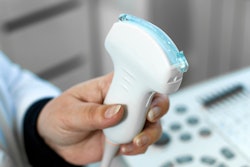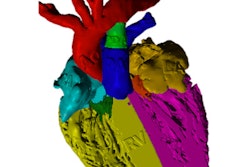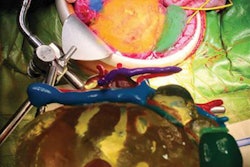
German researchers have found that shear-wave elastography (SWE) is a viable method for diagnosing increased intracranial pressure (ICP) -- a condition that can accompany hydrocephalus -- in newborns and infants.
The findings are good news for clinicians dealing with this dangerous condition in children, wrote a team led by Dr. Timm Dirrichs of Aachen University Hospital.
"Precise awareness of a child's ICP is of particular clinical interest, especially in critically ill neonates and infants the results of whose quantitative ICP measurements are often essential when it comes to planning further treatment," the group wrote in the November issue of Investigative Radiology. "Accordingly, there is great need for precise and easy-to-perform techniques for evaluating ICP."
A severe state
ICP in newborns and infants is a severe disease state that needs both quick and accurate diagnosis and rapid and efficient treatment, but early diagnosis can be a challenge, they noted. Traditionally, ICP has been diagnosed invasively by lumbar puncture; noninvasive options include measuring the optic nerve sheath diameter or compression of the fontanel, but these methods aren't as accurate as necessary.
Imaging-based noninvasive methods for diagnosing ICP include ultrasound (B-mode and Doppler) and MRI, but they both have their drawbacks, according to Dirrichs and colleagues. Because SWE has been shown to be a powerful tool for evaluating tissue stiffness in the breast, thyroid, and prostate, it has been posited that it could be a useful tool for the brain as well (Invest Radiol, November 2019, Vol. 54:11, pp. 719-72).
"In the past few years, SWE has been used to evaluate both normal and pathologic tissue stiffness in multiple organs, but so far, only a few reports are available about using SWE in the human brain," the researchers wrote.
They investigated the technical feasibility of using SWE as an additional method for diagnosing and monitoring ICP in hydrocephalic children, comparing the SWE values of healthy children and those who had hydrocephalus and were suspected of having increased ICP.
The study included 166 newborns and infants with a mean age of 12 weeks; of these, 110 were healthy and asymptomatic and 56 had hydrocephalus. Of those with hydrocephalus, 38 showed clinically increased ICP and 18 did not; 47 children had invasive ICP measurements available. All underwent B-mode ultrasound, Doppler ultrasound, and SWE, which were read by one of two radiologists. Dirrichs' group then compared SWE values with each child's clinical symptoms and with their invasive ICP measurement results.
The researchers found that SWE was technically feasible, providing consistent measurements in 88.7% of the healthy children and 93.3% of the children with hydrocephalus. SWE values were higher in patients with hydrocephalus than in healthy children (p = 0.0083), which indicates increased rigidity in the brain's parenchyma.
The results also showed an association between increased ICP and increased SWE values: Mean SWE values were 30.8 kPa in children with confirmed ICP, compared with 16.2 kPa in those without ICP.
| SWE values in children with and without hydrocephalus | ||||||
| SWE | Healthy subjects | Children with hydrocephalus | All with hydrocephalus | With hydrocephalus and invasive data available | ||
| With ICP | Without ICP | With ICP | Without ICP | |||
| Mean kPa | 14.1 | 21.8 | 24.2 | 20.3 | 30.8 | 16.2 |
"Our study is the first systematic evaluation of SWE as a method of determining ICP in hydrocephalic children with increased ICP," Dirrichs and colleagues stated. "We were able to find a positive correlation between SWE and ICP in infants confirmed to have hydrocephalus, as compared with a healthy, nonhydrocephalic control group."
Game changer?
Because clinical decisions regarding the treatment of hydrocephalic children are often difficult to make -- especially whether a child needs excess fluid to be drained, which can be dangerous -- the fact that SWE is feasible and effective could be a game changer, according to the researchers.
"Our results anticipate that SWE might be an additional, reliable tool for improving clinical, noninvasive estimation of ICP, and could aid in decisions about the need for invasive drainage in a child," they concluded.



















